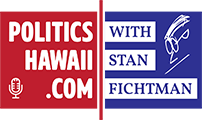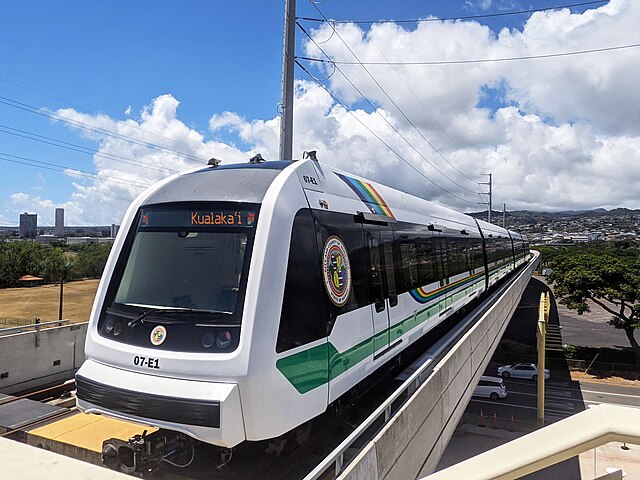By now, most readers of this blog have seen either the short snippet or long-form commercials announcing the extension of the Skyline rail system on Oʻahu to the Airport and Middle Street.
Along with the ads, a new tagline is being rolled out – “Skyline, always on time.” As an aside, this blogger is seeing that the Honolulu Authority for Rapid Transit (HART) is finally figuring out how to market the system positively to residents who, for years, have been barking and moaning about the system, from the price to the construction.
However, the idea of the rail rolling on tracks in the second phase to the airport was, at the origin of the project, not a done deal. In fact, it would be a tale of an idea to move the second phase, a lot of passionate advocacies by both proponents and opponents of the move. And at the end, an accusation that a community got shafted over the change.

(Top to bottom)
Charles Djou
Romy Cachola
Todd Apo
Mufi Hannemann
All were in the government of the City and County during the debate and change.
(PC at the bottom of the article)
This is the tale of the “Airport Spur,” from a first-person perspective – this blogger – me – as I was there working at the City Council when the idea popped up from my boss, at the time, former Councilmember Charles K. Djou.
For a long time before the “change” in the second-phase route, there were a lot of questions as to why the original rail concept never had stops at what Daniel K. Inouye International Airport (known back then as Honolulu International Airport) is now. Instead, in its first iteration, the system would go from Hālawa into the Salt Lake district, winding along Salt Lake Boulevard.
That decision, it turns out, was made to secure the vote for the project by the Councilmember of the area, Romy Cachola. His vote in 2007 to approve the guideway routing was the pivotal fifth vote on the Council. He made a deal for his “yes” vote if the line were to go through Salt Lake.
The deal was secured, and the guideway, with it going through Salt Lake, was approved. The subsequent justification that came from that vote was that the rail should serve more residents, with the thought that ridership numbers were better with that routing.
However, the counterpoint came from supporters of changing the route, who identified the workforce center that was the Pearl Harbor/Hickam Air Force Base/airport and eastern Kalihi. They argued that routing through this corridor would boost ridership even more than if it went through Salt Lake.
And for about a year, discussion on the decision simmered.
A larger debate was emerging whether the rail system was designed to support workforce transportation for those who lived on the west side to major employment centers, or for residents moving between residential districts. Advocates for the airport route cited the number of jobs in the airport area – approximately 15,000 people work daily in airport-related roles. That number goes up if you include civilian workers at the nearby military bases and even more if you include all residents in those areas.
In comparison, the argument for the Salt Lake routing was that it would serve the approximately 35,000 residents who would ride it into town when later phases through Kalihi and ending at Ala Moana Center were fully built out.
Both sides had a point, and if the choice could have been both, the debate would have been much different. But in this case, the Council had to choose only one.
Understanding that ridership numbers were what was at play, with realistic usefulness being considered, Councilmember Djou, in November 2008, introduced Resolution 08-261 and companion Bill 64 (2008), calling for the change of the rail route in Section III of the bill from Salt Lake Boulevard to Aolele Street – in other words, the airport corridor.
Then-Councilmember Todd Apo was the only other Councilmember to sign the resolution and bill. And then the debate ensued.
Of course, Councilmember Cachola was not happy with the change, noting that it was a bad move. Considering he was able to get the rail through Salt Lake – the district he represented – by playing hardball with the mayor in 2007, his reaction was not a total surprise.
But this time, Cachola’s vote was much less pivotal. In the first reading of the measures, they passed the Council 7 to 1, with Cachola the only “no” vote. The majority vote in the Council is five. From being the pivotal vote to being the only dissent, it was apparent that the better idea, from the Council’s and the mayor’s point of view, was to go through the airport.
From my first-person perspective, working in Djou’s office, this would be one of the last measures I would become involved in. At the time, Djou was buoyed by the fact that decisions were going his way and was gaining support both in the Council and in the public for the proposed change.
However, he was also working on other things, which would lead to him dismissing his staff about three weeks later in what the British call “a sacking.” From the beginning of December to the time the bills were finally passed in late January 2009, positive momentum for the change continued to build. By the time it passed, it felt almost anticlimactic – as if the rail was always destined to be this way.
While the Councilmember continued to pursue the buildout of HART, I proceeded to work at the State Department of Labor’s Workforce Development Council, learning how to write and manage grants – forming the genesis of what I do now for the University of Hawaiʻi Kapiʻolani Community College.
It’s easy now to believe the rail was always meant to go to the airport — that it was obvious from the start. But I remember when it wasn’t. The airport’s inclusion wasn’t destiny; it was a decision, argued and voted into being. And yes, he would dismiss me and the rest of the legislative team just weeks later, but credit is due where it’s due: Charles Djou saw the value of that alignment long before the city did. When we ride past after October 16, 2025, it’s worth remembering that what feels inevitable today was once anything but.
Photo Credits in article:
Djou: Stan Fichtman, Public domain, via Wikimedia Commons
Cachola: Ballotpedia at https://s3.amazonaws.com/ballotpedia-api4/files/thumbs/200/300/Romy-Cachola.jpg
Apo: NAIOP website at https://www.naiop.org/globalassets/bios/a/apo-todd-480×480.jpg
Hannemann: Office of United States Senator Daniel Akaka, Public domain, via Wikimedia Commons
Skyline train: eli fessler, CC BY-SA 4.0 <https://creativecommons.org/licenses/by-sa/4.0>, via Wikimedia Commons

